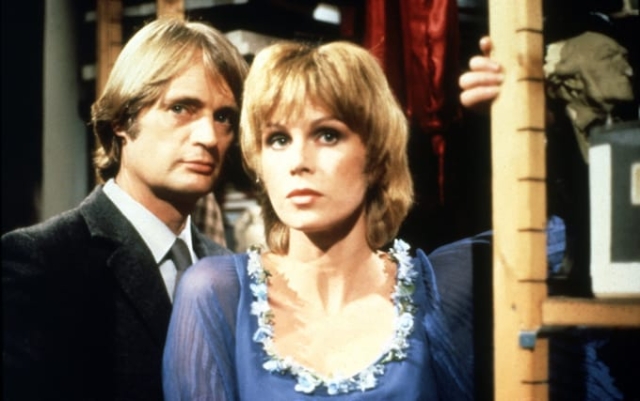 Creepy: David McCallum and Joanna Lumley in Sapphire & Steel Credit: Alamy
Creepy: David McCallum and Joanna Lumley in Sapphire & Steel Credit: Alamy
He was the man of the most beloved TV shows of the sixties, seventies and eighties. David McCallum, who has died aged 90, brought movie star charisma to the small screen with iconic roles in Colditz, Taken and, of course, The Man from U.N.C.L.E. went well with the cool collaboration style. star Robert Vaughn.
This aura of celebrity was due to the fact that by the time he signed with U.N.C.L.E in 1964, he was truly a movie star. He appeared in the epic Titanic before James Cameron's A Night to Remember, worked with John Huston on Freud: The Secret Passion and starred opposite Steve McQueen in The Great Escape.
However However, it was television that made him lasting famous, starting with U.N.C.L.E., where he brought the lighthearted humor to Ilya Kuryakin, the stolid Russian sidekick of «Napoleon Solo» Vaughn.
U.N.C.L.E. — an acronym for Unified Network Law Enforcement Command — was a fantastic showcase for McCallum's understated performance. But that wasn't the only highlight in a career that spanned decades. In the Eighties, he starred opposite Joanna Lumley in one of television's strangest dramas, a creepy, esoteric time-travel saga that made Doctor Who look like Dallas.
Sapphire and Steel investigated the adventures of a pair of time-traveling super agents, Sapphire (Lumley) and Steel (McCallum). Their mission: to outwit ghosts, aliens and other malevolent creatures. And scare the hell out of tea party audiences across Britain.
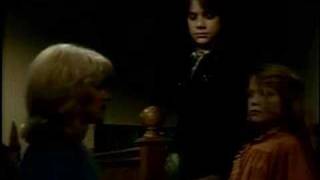
The trippy dystopia of Sapphire and Steel has been brought to life by ITV's tight-lipped production team. The parade of horrors they produced was extremely alarming. The restless souls of plague victims, a man in a bowler hat without a face, suffocated submariners. There was a nightmarish shovelful of fuel here.
It scared daylight viewers who tuned into the early evening timeslot for six seasons. And then Sapphire and Steel said goodbye to the mother of all shock endings.
The setting was a truck stop restaurant where Sapphire and Steel were lured by nefarious figures known as the Time Entities — the predecessors of Hugo Weaving's Agent Smith from The Matrix. The final twist came when Sapphire and Steel discovered that the cafe had been transported to deep space. That's how Lumley and McCallum picked up their bows — lost in space, staring into space.
Sapphire and Steel were planned to return. Alas, organizational changes within ITV led to its cancellation (Luther creator Neil Cross tried unsuccessfully to reboot it several years ago). However, it rose to the occasion: the truck stop episode became one of the most-watched shows of the week.
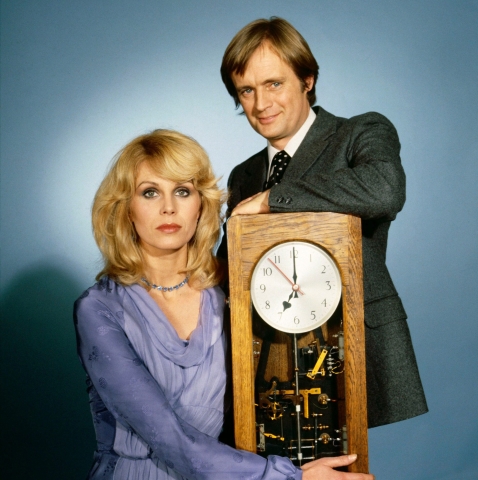 Time Time Joanna Lumley as Sapphire and David McCallum as Steel Photo: Shutterstock
Time Time Joanna Lumley as Sapphire and David McCallum as Steel Photo: Shutterstock
Lumley was a former Bond girl and a familiar face to ITV viewers. McCallum was more elusive as Steele, a testament to his ability to disappear into parts. He was born in Glasgow in 1933. His father was the leader of the Scottish Orchestra, as it was then called, and his mother was a cellist. The family left Scotland when David McCallum senior was appointed leader of the London Philharmonic Orchestra, although young David was evacuated to a village near Loch Lomond during the war. He continued his studies at the Royal Academy of Dramatic Art, where Joan Collins was a classmate.
McCallum's intense gaze meant he would never be a conventional leading man. But soon after graduating, he began working, co-starring with another future spy, Sean Connery, in the film Hell Divers. Six years later, in 1963, he landed a role in The Great Escape, playing Royal Navy Lieutenant Commander Eric Ashley-Pitt.
It's hard to imagine entertainment more removed from The Great Escape than cosmically strange «Sapphire and Steel». . However, the series is fondly remembered and has a cult following.
They are drawn to its distinctly dark atmosphere. In Doctor Who, time travel is a fun water slide: wherever the Doctor goes, there will be a splash. In Sapphire and Steel, on the contrary, time is intelligent and evil. We know this because Steele says so in the very first episode, in which he and Sapphire investigate the disappearance of her mother and father in a creepy house with too many clocks and not enough light sources. “You can’t enter time,” Steele tells the missing couple’s stunned son. “But from time to time it can enter the present… break in… break through.”
 Joanna Lumley as Sapphire Photo: ITV/Shutterstock
Joanna Lumley as Sapphire Photo: ITV/Shutterstock
If Sapphire and Steel is remembered in 2022, it's like the harrowing relief of late Seventies and early Eighties Spooks. This was the heyday of downright terrifying information videos and children's television so annoying that it now comes with health warnings for adults, not to mention children under 12.
Sapphire and Steel is certainly part of this tradition (it was originally intended to be a children's show in the vein of Children of the Stones). However, when viewed in the 21st century, it is clear that his legacy extends beyond this niche of popular culture.
“It was a precursor to The X-Files,” Lumley said, noting the parallels between her and McCallum's characters and the iconic Nineties duo Mulder and Scully. And it's hard not to imagine that David Lynch hasn't encountered Sapphire and Steel at some point. The understated creepiness and the way the mundane is rendered chilling indicate that he was a clear influence on Twin Peaks.
As with Twin Peaks, this oddity was largely due to series creator Peter J. Hammond's refusal to explain too much. One popular theory is that Sapphire and Steel are aliens sent to Earth (they have quasi-magical powers: Steel can lower temperatures; Sapphire can rewind time). Yet their extraterrestrial status is never confirmed—instead, we learn only that they are part of a team of interstellar explorers named after elements, gems, and compounds (we are introduced to the other two, Lead and Silver). «I didn't want to give too much away,» Hammond said, «because once you say where they came from, you're committed.»
 Sapphire & Steel is about a special task force of interdimensional agents. Photo: ITV/Shutterstock
Sapphire & Steel is about a special task force of interdimensional agents. Photo: ITV/Shutterstock
Hammond was a part-time TV writer who worked on such venerable series as Dock Green's Dixon and Z Cars before finishing his apprenticeship on Emmerdale and The Sweeney. Before Sapphire and Steel, his breakthrough project was Ace of Wands, a children's show about a magician with telekinetic powers.
His success convinced Thames TV to commission him to write another children's series, The Time Benders. However, it was considered too disturbing — even for the seventies — and was shelved. Enter pirate producer and Svengali Lew Grade, who is no stranger to TV greenlighting Patrick McGoohan's 1967 film The Prisoner.
He was photographed by Time Menders for its ITV Associated Television franchise. Retitled Sapphire and Steel and reconfigured for adults, it appealed to Grade because, despite its scary and esoteric nature, its use of interior locations and dialogue-driven plot ensured it could be put together on a string.
Grade knew that smart casting was critical. And so he opened his checkbook to megawatt duo Lumley and McCallum. Arriving on set, Lumley may well have felt that most of the budget was spent on her salary. “It was made for chips — like everything else then,” she declared.
But the lack of resources didn't deter her, and she was startlingly serious as Sapphire, though her performance was judged as decidedly raunchy on par with the even dourer McCallum. It was a partnership forged in creepy TV heaven, and over those half-dozen seasons, each consisting of several interconnected episodes, they created perhaps one of the greatest British sci-fi shows ever.
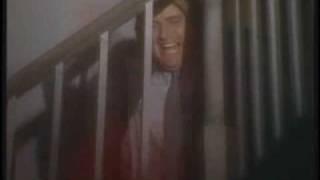
The horror factor was at the forefront, even though it was pre-watershed. The first season takes place in a haunted house caused by a young girl reading The Ring of Roses. Even creepier, the second episode is set in an abandoned railway station haunted by a spirit who was shot dead by a WWI soldier just hours after the Armistice. Later Sapphire & Steel introduced aliens who have declared war on meat-eating, and the aforementioned Time Creatures, who dress like regional bank managers but whose eyes glow red.
However, despite all their creepiness, Sapphire and Steel were generally easy on gray matter. All participants felt an obligation to make television accessible to the average viewer. “My mother used to have a cleaner, Mrs. Puttock,” McCallum said, “and she saw the first episode and said to me, ‘I liked it, but I didn’t understand it,’ so we always tried to make sure Puttock-proof stories However, the potential audience for chilling, micro-budgeted time travel television will always be limited. So, in 1982, when ATV was acquired by Central Television, the plug was pulled. And at the same time, the exciting story in which Sapphire and Steel are lured into a restaurant at the edge of the universe was doomed to never be resolved. It still bothers at least one of the participants to this day. “I hate it,” Lumley lamented. “I'm still there. I'm stuck at this gas station.











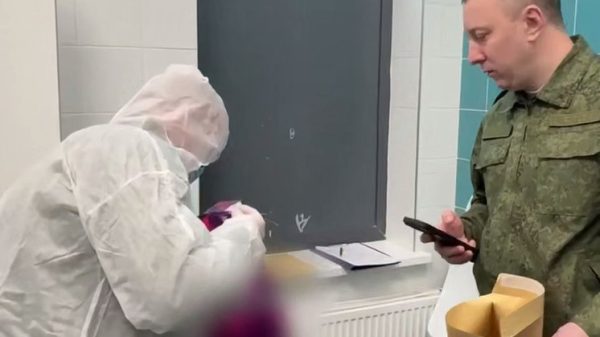








































Свежие комментарии